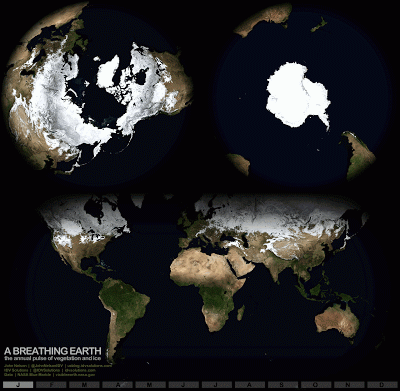In a few weeks, the latest United Nations / World Meteorological Organization assessment of the state of the climate will be released by the Intergovernmental Panel on Climate Change (IPCC). The IPCC report will include revised estimates of the rate of sea level rise, both from ocean water expanding and from contributions from snow and ice melting.
 This post is part of a series on
This post is part of a series on
The Intergovernmental Panel on Climate Change (IPCC)
Subscribe to the series RSS feed.
In the last IPCC report in 2007, the sea level rise projections listed in the summary document did not include the full estimated contributions from changes in ice flow and melting of the two great ice sheets on the planet, Greenland and Antarctica. This led to erroneous speculation in media coverage that the projected sea level estimates were lower than previous reports. Hopefully the forthcoming report will be more explicit about all of the contributions to sea level rise – the fact is, snow and ice are rapidly melting and raising sea levels.
Snow and ice – a barometer of Earth’s climate
In the last two decades I’ve seen with my own eyes the rapid disappearance of many of the planet’s snow fields and the retreat of alpine glaciers. Unfortunately, my anecdotal observations are backed up by data and are clearly linked to global warming.
Over the last century, in the Sierra Nevada the surface area of glaciers has been decreasing and spring river runoff is lower. In Montana’s Glacier National Park over the same period the number of sizable glaciers has dropped from 150 to less than 25. In Wyoming, the 44 extant glaciers in the Wind River Range have decreased in area by almost half in the last four decades. And it’s not just confined to North America. Glaciers are in retreat worldwide – in Switzerland, in Peru, in New Zealand. If snow doesn’t endure through the summer, glaciers simply cannot grow. Snow needs to remain for multiple seasons for it to form into ice and become a moving glacier.
The disappearance of land-based snow and ice

Thermal expansion of the oceans now takes a back seat to the contribution from melting of land-based ice (which was not accounted for in previous projections of future sea level rise). Source: UCS (after Church et al., 2011)
What happens to our snow fields, our alpine glaciers, and our ice sheets truly matters. The melting and retreat of northern hemisphere snow and ice due to global warming is a concern for two major reasons. The first is that when land-based ice melts, sea level rises. The second is that removing snow and ice cover on land leaves behind a darker surface which increases the amount of sunlight that is absorbed at earth’s surface – a feedback that increases the original warming.
When land-based ice melts, sea level rises
For most of the last century, thermal expansion from simply heating up the ocean was the main contributor to the global rise in sea level. But that’s changed in the last two decades.
A recent study shows melting of land-based ice and the resulting runoff into the sea now accounts for twice as much sea level rise as thermal expansion does. More than half of the contribution from land-based ice is from melting of alpine glaciers and ice caps, while Greenland and Antarctica (both ice sheets) account for the rest.

NASA satellite images show the changing extent of snow and vegetation for the globe over the course of the year. The greatest seasonal changes occur in the northern hemisphere. To persist, alpine glaciers and ice sheets need snow to accumulate from year to year. Top left is the view looking down on the North Pole, top right is the South Pole. Source: IDV Solutions
Greenland – the inappropriately-named island that is one of only two major ice sheets on the planet (Antarctica being the other) – is also experiencing major melt events annually. In the years 2007, 2010, and 2012 surface melt area was extensive and record-breaking. This year Greenland is experiencing a melt season closer to the long-term average. Don’t be fooled by 2013, though – the Arctic is still warming at twice the pace of the rest of the globe, as noted in the recent State of the Climate in 2012 report by the American Meteorological Society.
IPCC report highlights link between warming and loss of snow and ice
The contribution to sea level rise from melting of land-based snow and ice will continue to increase while emissions and temperatures rise. Our current challenge is to reduce our emissions swiftly and deeply to avoid the worst impacts of climate change. The forthcoming IPCC report will be a stark reminder that it is time to heed the science and act. The snow-speckled meadows and the majestic peaks surrounded by glaciers are surely worth saving not only for the services they provide like water supply and habitat, but also for the sake of future generations.
